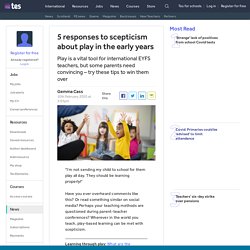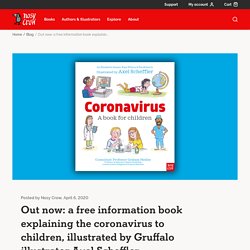

Low cost play ideas video transcript. Low-cost play ideas & materials. 5 ways to win over parents to the importance of play in international EYFS. "I’m not sending my child to school for them play all day.

Building on what children know (free article) - Early Childhood Australia. ‘Take the child on from where they are now’ has long been a slogan in early childhood, but I wonder, as educators, if we always do it? My four-year-old granddaughter, Mia, is extremely capable with modern technologies; she can use a mobile phone and digital camera and browse a DVD to select particular scenes in a movie. She is not ‘print literate’, but she is ‘techno-literate’. I’m not advocating techno-skills for babies, but I am conscious that this competence may not be valued as she goes into preschool. Assessment for learning.
Observation, Assessment and Planning - Early Years Matters. The EYFS Profile summarises and describes children’s attainment at the end of the EYFS. Early Learning for Every Child Today. A framework for Ontario early childhood settings. Microsoft Word - Information sheet - Documentation updated 26 May 2014 copy.docx. Pre-birth to Three: Observation, Assessment and Planning. Let’s lose the ADHD label and find the child. When I trained as a primary school teacher 15 years ago, these were some of the words used to describe children with ADHD: ‘Difficult.’

‘Challenging.’ ‘Disruptive.’ There were others, whispered by harassed-looking teachers in the staffroom or concerned parents at the school gates, but none seemed to be positive. When I got my first ‘real’ class to teach, and saw that some of the children came with the dreaded ‘ADHD’ label attached, I approached the new term with butterflies the size of dragons in my stomach. But here’s what it took me a few more years to learn… Michael wasn’t ‘difficult’ He struggled with impulsiveness, often shouting out in class, talking over other children and getting into arguments during games when he found it hard to wait his turn. Chloe wasn’t ‘challenging’ Development-Matters-FINAL-PRINT-AMENDED.pdf. Released today: a free information book explaining the coronavirus to children, illustrated by Gruffalo illustrator Axel Scheffler.
Axel Scheffler has illustrated a digital book for primary school age children, free for anyone to read on screen or print out, about the coronavirus and the measures taken to control it.

Published by Nosy Crow, and written by staff within the company, the book has had expert input: Professor Graham Medley of the London School of Hygiene & Tropical Medicine acted as a consultant, and the company also had advice from two head teachers and a child psychologist. The book answers key questions in simple language appropriate for 5 to 9 year olds: • What is the coronavirus? • How do you catch the coronavirus? • What happens if you catch the coronavirus? We want to make sure that this book is accessible to every child and family and so the book is offered totally free of charge to anyone who wants to read it. Kate Wilson, Managing Director of Nosy Crow, said: Axel Scheffler, illustrator of The Gruffalo, said: We have also created a free audio edition of the book, read by Hugh Bonneville.
The Power of Positive Adult-Child Relationships: Connection is the Key. Positive Learning Environment - Primary. Understanding Schema in Children’s Learning. An Introduction to How Does Learning Happen? Ontario’s Pedagogy for the Early Years. For Educators. NQS_PLP_E-Newsletter_No36.pdf. Key Person & Attachment - Early Years Matters. The Key Person. How Are Happiness and Learning Connected? As teachers, we also know that when students' affective filters or defenses are sky high, fight or flight responses will be modus operandi.
A room full of defensive behaviors (withdrawn, angry) is a sad, unproductive place to teach and learn. Now let's flip it and take a look at how much more we are able to learn when we are in harmony with the people and things in any given educational environment. Guiding Principles for Use of Technology with Early Learners. The thoughtful use of technology by parents and early educators can engage children in key skills such as play, self-expression, and computational thinking which will support later success across all academic disciplines and help maintain young children’s natural curiosity.
The Departments recognize that families and early educators have many different options for using technology with early learners. The Departments believe that guidance needs to reflect the reality that families and early educators have access to apps, digital books, games, video chatting software, and a multitude of other interactive technologies that can be used with young children.
Even as new technologies emerge, the Departments believe that these principles apply, though guidance may evolve as more research on this topic is published. Whole Child Development Is Undervalued. The question is how to make such an approach both systemic and sustainable.
Whole Person Socio-emotional, physical, creative, and cognitive capacities are deeply intertwined and equally important in ensuring a child's wellbeing, learning, and growth. (That shouldn't be a surprise to anyone studying or supporting children's learning.) Nobel laureate James Heckman, a professor of economics at the University of Chicago, has shown that the non-cognitive skills emerging in early childhood are among the strongest predictors of adult outcomes. What to consider when teaching English in large classes. How many students do you teach?
Do you feel that your classes are too big? Author and education consultant Jason Anderson looks at the issues and offers some potential solutions. For many of us, our classes are larger than we would like them to be. They can present a number of challenges that teachers of smaller classes are less likely to face. But what exactly do we mean by large classes? Definitions of a large class What we label a ‘large class’ depends mostly on context and expectations. In this article, we will take the midpoint between these two figures. Whole Child Development Is Undervalued. Poems for kids. Nursery Rhymes and Songs - BBC Teach. Music and Movement Activities for Toddlers and Preschoolers.
50+ Quick & Easy Kids Crafts that ANYONE Can Make! Songs for kids. Short stories for kids. How to teach children English using illustrated storybooks. What makes illustrated storybooks such a good resource for teaching young learners of English? The British Council’s Gail Ellis, co-author of a storytelling handbook for primary English language teachers, explains.
Listen to an interview with Gail in our podcast and register for her webinar taking place on Thursday, 2 October. Factsheet 2: Physical Activity Guidelines for Early Years. Factsheet 1: Physical activity guidelines for early years. Nihms175063.pdf. Mark Making Matters: Young children making meaning in all areas of learning and development.
The Art of Control. Executive function — our ability to remember and use what we know, defeat our unproductive impulses, and switch gears and adjust to new demands — is increasingly understood as a key element not just of learning but of lifelong success. Researchers at the Center on the Developing Child at Harvard University describe executive function as an air traffic control system for the mind — helping us manage streams of information, revise plans, stay organized, filter out distractions, cope with stress, and make healthy decisions. Practical tips. By Opal Dunn, educational consultant and author Introduction Young children learn English differently from most adults.

Most have an innate ability to pick up English while taking part in activities, by making sense of what they are doing and picking up the adult’s language that accompanies the activity. You can find out more in the British Council booklet ‘How young children learn English as another language’, also available on the parents pages of the LearnEnglish Kids website. Planned English sessions. How to help your child learn English with YouTube videos. Tracey Chapelton, education consultant and materials writer, has some advice for parents of young English learners, whose home language might not be English. To learn a language we need a lot of exposure to it.
YouTube is beneficial if you are not a fluent English speaker, and want a more fluent model of English for your child. Helped along by the visuals of their favourite cartoon, children can watch their favourite characters involved in adventures, while absorbing the language. Repetition is also important for language learning. Ten ways to support your child’s English-learning at home. As the British Council opens a new Learning Time with Shaun & Timmy centre in Mexico for two- to six-year-olds, senior teacher Sarah Reid offers some useful tips for supporting your child’s learning at home. More and more parents want their children to learn English from a young age. I often meet parents of children as young as two or three who say that proficiency in speaking English will help their child 'get ahead in a globalised world'.
In other words, the sooner their children get started, the better. The single most important factor in a child’s success with English is their parents' interest and encouragement, no matter what their child’s age. (PDF) Foundation Stage, Early Years: Learning Through Play. Sound Words: Examples of Onomatopoeia. Onomatopoeia is a fun, linguistic tool used in literature, songs and advertisements. Now that you've seen examples of the individual words, consider the following examples of onomatopoeia words in use. Take a look at the different onomatopoeia examples in Todd Rundgren's song, appropriately named Onomatopoeia. The Power of Positive Adult-Child Relationships: Connection is the Key. Talking with Babies and Toddlers. PowerfulInteractions.pdf.
Effective_ways_to_help_children_s_early_language_development_POSTER.pdf. Review English in Early Childhood: Language Learning and Development. Effective Teacher-Child Interactions. Carol Dweck: The power of believing that you can improve. How can parents and teachers best educate young children?
The Power (and Peril) of Praising Your Kids. LINKS WEEK 1. Convention on the Rights of the Child. Arabic | Chinese | French | Russian | Spanish. Tip Sheet for Parents - Why play is important. Play-based-learning_statement_EN.pdf. New doc for perfect B. (PDF) Foundation Stage, Early Years: Learning Through Play. Taking Playtime Seriously. So part of encouraging play is pulling back on how much programmed goal-directed learning we expect from very young children, to leave them time for the fun of exploration, curiosity and, well, fun. David whitebread importance of play report. Importance of play for babies & children.
How young children learn English through play. ZERO TO THREE. Our play resources. Teachers TV- How Do They Do It In Sweden? Tina Bruce (2015) Early Childhood Education 5th Edition. Different types of play tip sheet. 6 Types of Play: How Children's Play Becomes More Social. Play is a serious business. The pioneering developmental psychologist Lev Vygotsky thought that, in the preschool years, play is the leading source of development.
Getting the right balance between adult-led and child-initiated learning.